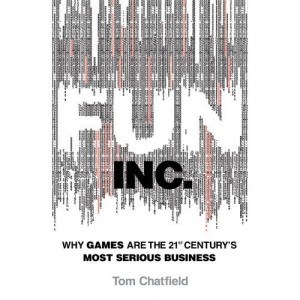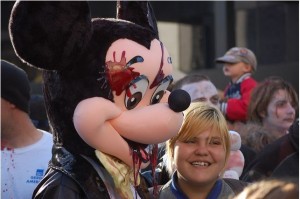 Here’s what I learned at the 2011 Game Developers Conference:
Here’s what I learned at the 2011 Game Developers Conference:
The most interesting dialog about games has moved from a sort of constrained, technical conversation around the ins and outs of making games that people want to buy and play to a messy free-for-all of blinding insight, hard-won experience and philosophical examination. Gaming discourse now serves up a Las Vegas-style buffet of knowledge where anything you want is available, in any quantity, and at a reasonable measure of quality.
The trouble is, as you nibble on your lamb curry and naan, prime rib with baked potato, taquitos swimming in green chili and frozen yogurt topped with blueberries, you realize that you are in for some serious indigestion later. No buffet can claim a spot as cuisine anymore than the dialog at GDC passes for a coherent system of thought.
And in both cases, it’s the things themselves–the donuts and sushi, the game dynamics and mechanics with their messages–lack some sort of organizing theme, some principle of diet, whether for the body or the mind, that makes it all digestible, that we can use to make sense of it all. And every year the GDC stomach ache gets worse.
At the bar in the top of the Marriott in dowtown San Francisco, I explained this to a some seasoned game developers:
In art, at the center, is the concept of beauty. The notion of “beauty” is loose. It is contested. It is even frequently denied its central role in many contemporary notions of the form. But what no one who wants to talk about art can do is ignore beauty. You can go around it or you can go through it, you can try and transform it or turn a blind eye toward it. You just can’t get away from it and still talk about art. It’s the thing at the center that keeps the globulous notion of art sensible; it’s what unites a crucifix in a jar of urine with a 2,000 year old marble bust. The universe of art orbits the the giant galactic sun of beauty.
So I say to my game dev colleagues–See, games have no center!
And I wave my hands like fireworks to emphasize the point.
To which one of them replies, unimpressed. “Sure we have a center. It’s fun”
I blink for a moment. Then I send my hands into an encore of enthusiasm.
Exactly! Fun is the center. But no one will talk about it! Walk the floors of GDC or scan the program. Fun is not on the menu. Fun is a dirty word. Fun is the middle of games, but it’s missing.
You’d think it would be there, right out in front, exposed, the target for every whip smart developer and smack talking wag lining up to analyze games. It seems that a brain trust like Frank Lantz would hit it, but he just wants to dismiss fun in a search for something sublime, something beautiful. Clint Hocking seems to reflexively understand the very nature of fun when you play his games, but he slips right past the main event to dissect a a specialized part of the game machine, the dynamic. Chris Hecker and Jonathan Blow, august senior members of the game development intelligentsia understand it in their bones, but slip into related, but tangential, rhetoric when they try to put into words what they do.
The GDC bookstore is like the Alexandria Library of game wisdom. Its shelves creak with the accumulated and printed knowledge of the entire industry, Still, it’s shelves were short on fun. Raph Koster’s “A Theory of Fun” was featured prominently by the cash register. Yet, despite its ample value, it never really manages to come up with much to say directly about its title topic.
Even the annual appearance of Marc LeBlanc and his useful rubric of “8 Kinds of Fun” in the GDC Game Design Workshop can stimulate design thought, but commits all kinds of inductive errors looking for definition of fun by categorizing the shattered experiences of a thousand games. You might as well look for beauty in a room full of fashion models.
These examples don’t build a complete argument, of course. Rather, they help illustrate the fundamental puzzle that fun, when we talk about it all, is something to the side of games, some slang term game players sloppily throw around because they can’t think of more precise, more designerly words to use. Fun is there, we just don’t like to talk about it. It’s as if you go to art school and are told, “Don’t talk about beauty. That’s just a marketing term we use to sell our works to hoipolloi saps.”
Why fun doesn’t receive a warm welcome in the game business remains a puzzling question. But knowing game design and development’s general impatience with ambiguous concepts, the reason may not lie far from a general lack of introspection in the industry. If we can’t measure it, it must not hold much value.
Then again, to me, the more likely culprit lies with the central problem that game developers may love what they do, they just don’t find it fun. Like a shutdown cornerback in the NFL, the game he plays is performed with solemn intent. His professional game may bring great joy, but fun is not the right word. It’s like an elder Beethoven composing while deaf. He didn’t need to hear the music to understand it. He enjoyed what he did in an entirely different aspect. Game designers don’t need fun to make their fun machines, so they stop talking about the thing in the middle.
So what of this fun thing, this thing that is different for everyone, this thing that is totally contextual and not worth talking about because it is shorthand for a raft of unrelated pleasures that games can evoke? What of this ambiguous concept “fun”? If the conversation around games is like a Fur’s Cafeteria after a food fight, stuff thrown everywhere and useless to almost anyone, that might just be a natural result of fun not standing for anything in particular. This would make games subject to all kinds of competing tendencies, desires and objectives. Fun then,would just be a code word word for confusion.
Except, that hardly makes any sense at all.
If there is no central pleasure to games, then a game industry is hardly possible. If taste is truly a precious an unique snowflake, then, to once again invoke the food analogy, cuisine is not possible. You can’t have the concept “hamburger joint” if there is not some consensus on taste that agrees–hamburgers are yummy enough that it’s worth making a place called the Hamburger Shack. So it goes with games where, in spite of the suggestion that the diversity of genre would suggest that there is evidently no consensus, it really argues the opposite. Genre shows that broad categories are not only possible, they are integral to the form. Game players line up in self-identified groups, from Nintendo fan boys to the RPG aficionado, in the fighting game crowd and the first person shooters fans and the casual gamers. These alignments mean something to the people that abide by them and its some shared, not something fractured.
Then there’s the meta category, the bucket that holds all the genres and player types and that’s the notion of games itself. Games make sense because they are about something that makes them games. They have a center, a middle, through which the categorical theme of gameness threads.
Fun.
Games, at their center, at their heart are fun. When they stop being fun, then turn into chores, into jobs and into compulsions. When games stop being fun, they become raw systems and simulations. Sure, these might be useful and even interesting. But like a fine painting tossed into a Bolshevek barrel to warm a crowd, the thing becomes instrumental and suddenly looses its former aura. For the burning painting, the beauty gives way to warmth. For games, the fun submits to a dull rationality.
 This spring I had a chance to sit down with Ian Bogost and talk about Cow Clicker. Like a lot of people, I find Cow Clicker fascinating. Like a lot of people, I don’t think Cow Clicker is fun, at least in any ordinary sense. Perhaps unlike a lot of people, I think that Cow Clicker is fun in a deeply ironic way because it was designed not to be fun.
This spring I had a chance to sit down with Ian Bogost and talk about Cow Clicker. Like a lot of people, I find Cow Clicker fascinating. Like a lot of people, I don’t think Cow Clicker is fun, at least in any ordinary sense. Perhaps unlike a lot of people, I think that Cow Clicker is fun in a deeply ironic way because it was designed not to be fun.

